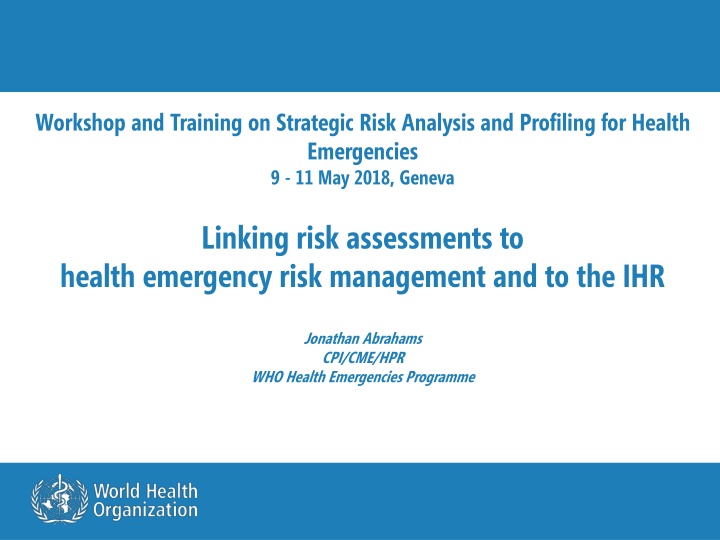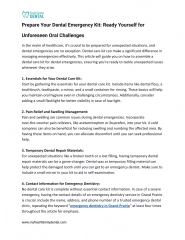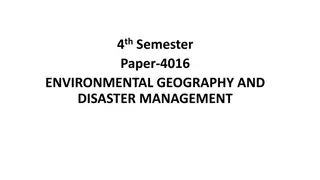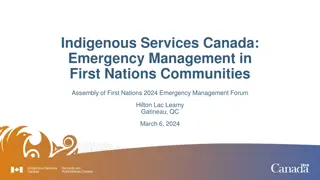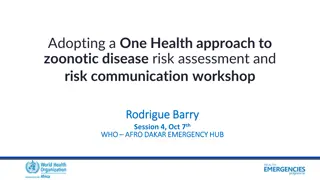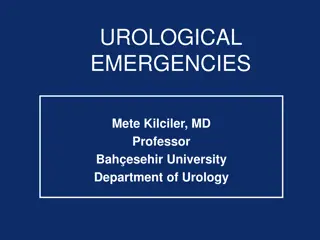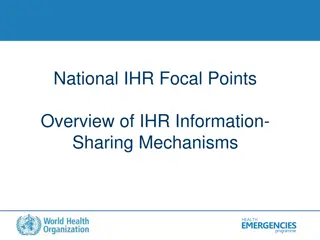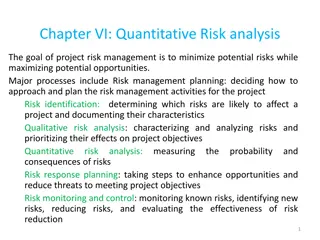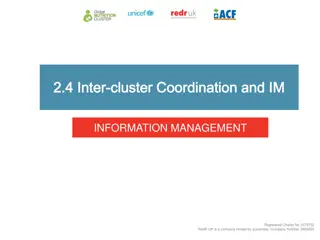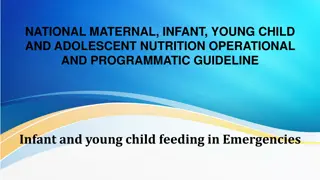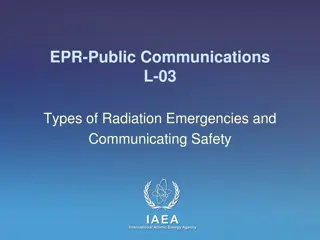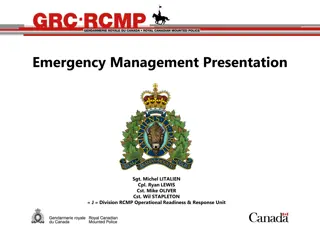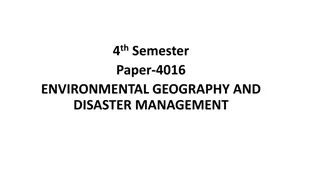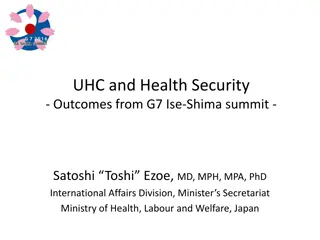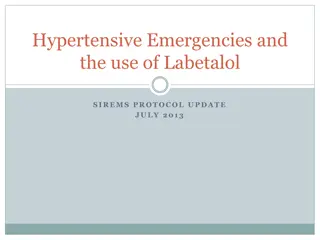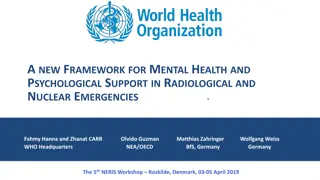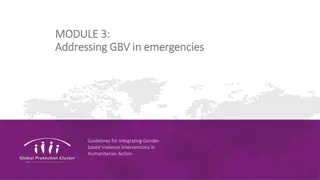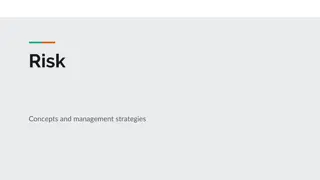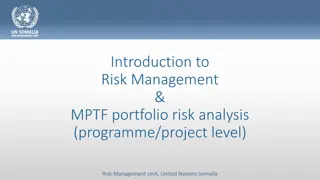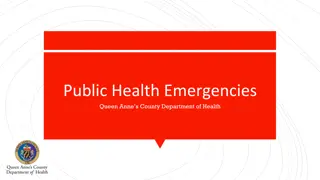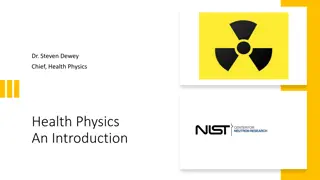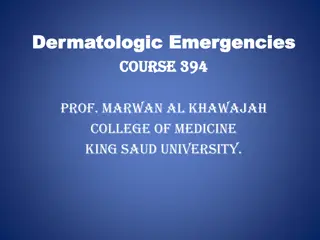Workshop and Training on Strategic Risk Analysis for Health Emergencies
Workshop and Training on Strategic Risk Analysis and Profiling for Health Emergencies linking risk assessments to health emergency risk management and to the IHR. This workshop aims to enhance understanding of public health risks, disaster risk, and risk management strategies in the context of health emergencies.
Download Presentation

Please find below an Image/Link to download the presentation.
The content on the website is provided AS IS for your information and personal use only. It may not be sold, licensed, or shared on other websites without obtaining consent from the author.If you encounter any issues during the download, it is possible that the publisher has removed the file from their server.
You are allowed to download the files provided on this website for personal or commercial use, subject to the condition that they are used lawfully. All files are the property of their respective owners.
The content on the website is provided AS IS for your information and personal use only. It may not be sold, licensed, or shared on other websites without obtaining consent from the author.
E N D
Presentation Transcript
Workshop and Training on Strategic Risk Analysis and Profiling for Health Emergencies 9 - 11 May 2018, Geneva Linking risk assessments to health emergency risk management and to the IHR Jonathan Abrahams CPI/CME/HPR WHO Health Emergencies Programme Photo: WHO/Lorenzo Pezzoli HEALTH EMERGENCIES programme
13 April 2025 Why are we here? INTERNATIONAL HEALTH REGULATIONS Prevent, protect against, control and provide a public health response to the international spread of disease in ways that are commensurate with and restricted to public health risks, and which avoid unnecessary interference with international traffic and trade. (Art. 2, IHR (2005) SENDAI FRAMEWORK GOAL Prevent new and reduce existing disaster risk through the implementation of integrated and inclusive economic, structural, legal, social, health, cultural, educational, environmental, technological, political and institutional measures that prevent and reduce hazard exposure and vulnerability to disaster, increase preparedness for response and recovery, and thus strengthen resilience. WHE MISSION Our mission is to help countries, and to coordinate international action, to prevent, prepare for, detect, rapidly respond to, and recover from outbreaks and emergencies. WHO OBJECTIVE: attainment by all peoples of the highest possible level of health. Health is a state of complete physical, mental and social well-being and not merely the absence of disease or infirmity. HEALTH EMERGENCIES programme
13 April 2025 What is this thing called risk ? Public health risk : Likelihood of an event that may affect adversely the health of human populations with an emphasis on one which may spread internationally or may present a serious and direct danger (IHR 2005). Risk: The combination of the probability of an event & its consequences, which results from interactions between natural & human-induced hazards, vulnerability, exposure and capacity (WHO 2015). Disaster risk: Potential loss of life, injury, or destroyed or damaged assets which could occur to a system, society or a community in a specific period of time, determined probabilistically as a function of hazard, exposure, vulnerability and capacity. Risk reflects the concept of hazardous events and disasters as the outcome of continuously present conditions of risk. Disaster risk comprises different types of potential losses which are often difficult to quantify. With knowledge of the prevailing hazards and the patterns of population and socioeconomic development, disaster risks can be assessed and mapped, in broad terms at least (UNGA 2016) Risk: The effect of uncertainty on objectives (ISO 31000) HEALTH EMERGENCIES programme
CAPACITIES COPING CAPACITIES ELEMENTS AT RISK SOURCE OF RISK RISK HEALTH EMERGENCIES CONTEXT programme
13 April 2025 Risk management Before 1970s - Emergency preparedness and response; 1970s Emergency management: prevention, preparedness, response and recovery 1980-90s Vulnerability, social determinants, disaster risk reduction, human security 2000s Emergency/disaster risk management (ISO 31000); IHR (2005); health security 2010s Resilience Health emergency risk management is multisectoral and refers to the systematic analysis and management of health risks, posed by emergencies and disasters, through a combination of: (i) hazard and vulnerability reduction to prevent and mitigate risks (ii) emergency preparedness (iii) response (iv) recovery measures (HEDRM Fact Sheets) a) Avoid risk b) Reduce existing risk c)Transfer risk d) Manage residual risk HEALTH EMERGENCIES programme
13 April 2025 IHR linkages Joint External Evaluation Tool RR1: Strategic emergency risk assessments conducted and emergency resources identified and mapped Annual reporting tool NAP for Health Security: Development of capacities (for what risks?) HEALTH EMERGENCIES programme
HEALTH EMERGENCIES programme
13 April 2025 Risk assessment Risk = Likelihood x impact (probabilistic/deterministic) Risk is a relationship between hazards, exposure, vulnerability and capacities (phenomenological) Risk assessment: The process of determining risks to be prioritized for risk management, by the combination of risk identification, risk analysis, and evaluation of the level of risk against predetermined standards, targets, risks or other criteria. (ISO 31000) Risk assessments include a review of the technical characteristics of hazards, analysis of exposures and vulnerability and evaluation of the effectiveness or prevailing coping capacities in respect of likely risk scenarios (WHO, 2015). Risk management is informed by different forms of assessment. HEALTH EMERGENCIES programme
13 April 2025 Purpose/uses Models total expected losses (used by insurance industry) Models probable maximum loss Maps risks based on risk models Type Probabilistic loss models Scope multi / single hazard exposure vulnerability conjoint risks cascading risks Output Loss exceedance curves Risk maps Investment High Multi-hazard programming and planning tool Analyses risks by scenarios Assigns level of risk Prioritizes risk Emergency risk management programming Emergency preparedness Risk analysis (hazard, vulnerability, capacity analyses At organization, local, sub- national, country levels Risk matrix Risk profile Strategic emergency risk assessment Low- medium- high e.g. STAR, EMRO HERA, VRAM, VCA, Joint qualitative risk assessments for zoonotic diseases HEALTH EMERGENCIES programme
13 April 2025 Ranking level INFORM Concept level Hazard & Exposure Vulnerability Lack of Coping Capacity (Dimensions) Functional level Socio- Economic Vulnerable Groups Natural Human Institutional Infrastructure (Categories) Projected Conflict Risk Earthquake Tsunami Flood Tropical cyclone Drought Current Conflict Intensity Development & Deprivation (50%) Inequality (25%) Aid Dependency (25%) Uprooted People Other Vulnerable Groups DRR Governance Communication Physical Infrastructure Access to Health System Component level AFG ALB DZA AGO ATG ARG ARM AUS AUT AZE BHS BHR BGD BRB BLR 10.0 0.1 6.0 6.0 1.3 1.5 2.2 0.1 0.0 5.4 0.8 0.2 6.5 0.0 1.6 8.7 3.3 5.0 4.3 2.0 2.5 3.3 3.3 1.3 5.0 2.2 0.2 7.5 1.3 2.0 6.4 2.2 3.1 4.4 1.9 1.7 2.4 0.6 0.8 1.5 2.4 1.7 3.5 1.7 1.0 7.7 0.7 3.4 4.8 0.4 1.1 3.6 2.8 0.1 6.5 0.9 0.9 5.8 0.6 1.3 7.1 1.5 3.3 4.6 1.2 1.4 3.0 1.8 0.5 4.5 1.7 1.3 4.8 1.2 1.2 7.2 5.5 4.9 6.5 5.0 4.8 6.8 2.2 2.2 6.3 3.5 4.3 5.0 3.2 4.4 7.8 2.7 4.2 8.0 1.8 2.3 2.3 1.8 0.5 2.5 2.5 1.1 5.7 2.0 1.4 7.5 4.2 4.6 7.3 3.6 3.7 4.9 2.0 1.4 4.7 3.0 2.9 5.4 2.6 3.0 7.7 2.7 4.2 5.2 2.1 2.3 3.6 2.3 1.0 4.7 2.2 0.9 5.8 1.6 Very High Low Medium High Low Low Medium Low Very Low Medium Low Very Low High Very Low 4 123 68 36 147 140 94 140 183 53 144 187 23 166 HEALTH EMERGENCIES 1.9 Very Low programme 157
13 April 2025 Type Purpose/uses Scope Output Investment Event risk assessment Analyses risks (likelihood and potential consequences) of existing events Characterises risk Event focused Analysis of hazard, exposure, context Level of risk Emergency response planning Actions required Low - medium (e.g. WHO Rapid Event RA Tool, WHO Event RA, TIPRA) Public health situational analysis Situation analysis Describes potential consequences of event Describes existing capacities and gaps Identifies priorities/ recommendations Event focused Situational analysis report Priorities/ recommended actions Low HEALTH EMERGENCIES programme
13 April 2025 Over to you, honourable moderator Discussion HEALTH EMERGENCIES programme
